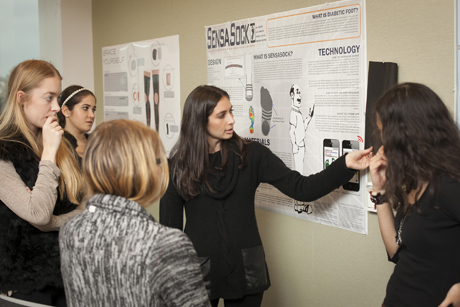Jewelry, socks ease diabetes and arthritis pain
By Sarah Cutler

For the 1.5 million Americans – most of them women – who suffer from rheumatoid arthritis, swollen, painful knuckles and wrists are part of daily life. But a team of Cornell undergraduates has a solution: a line of anti-inflammatory jewelry to make such chronic aches and swelling a thing of the past.
The idea for these bracelets, rings and midi-rings, made of a heat-absorbent textile that reduces joint swelling and inflammation, are four students’ final project in their Textiles, Apparel and Innovation course in the Department of Fiber Science & Apparel Design. Taught by associate professor Juan Hinestroza in the College of Human Ecology, the course requires students to develop product ideas – with feedback from local citizens – for functional apparel to help the elderly and other populations living with the daily discomfort of diabetes and arthritis.
Because most women who suffer from rheumatoid arthritis are between 30 and 50 – in their prime working years and active in their daily lives – the students aimed to create an aesthetically pleasing medical solution that could be disguised as everyday jewelry and wouldn’t make the wearer feel self-conscious.
“We wanted to create more of a fashion accessory than a medical product, something that wasn’t embarrassing to wear,” said Samantha Dichter ’14, one of the students who designed the jewelry.
Another group reinvented bulky leg braces with a sleeker alternative, called “BraceYourself,” which uses heel cushions and simple supports to decrease pressure on the knees and reduce the pain of osteoarthritis. The brace also provides heat around the knee joint to alleviate soreness and, like the jewelry, does not draw extra attention.
Other innovations from the course include gloves to alleviate pain and improve dexterity in arthritic fingers and SensaSock, an antibacterial and antifungal bootie for diabetics that uses tiny ultrasound sensors to monitor real-time blood flow through the wearer’s legs and feet.
Each year, Hinestroza teaches students about ailments that millions live with, especially senior citizens coping with chronic pain. His students research the characteristics of a different disease and develop a product or item of apparel that helps people function better. The class was aided by David Feathers, assistant professor of design and environmental analysis, who researches ergonomics and biomechanics.
“The class is about finding ways to make life easier” for people suffering from pain, said Rebecca Dugal ’14. “Professor Hinestroza makes inventing accessible,” she added. “It’s often viewed as an eccentric thing to do, but he brings it down to a place where it’s just problem-solving.”
Hinestroza said that several teams intend to file patents for their inventions and will explore bringing them to the market.
“The goal is for the students to learn new materials and new technologies, and to use that knowledge to improve people’s quality of life. At the same time as you learn, you gain an understanding of aging and pain,” Hinestroza said. “My students did a fantastic job, and I’m very proud of them.”
Sarah Cutler ’16 is a student communications assistant for the College of Human Ecology.
Media Contact
Get Cornell news delivered right to your inbox.
Subscribe